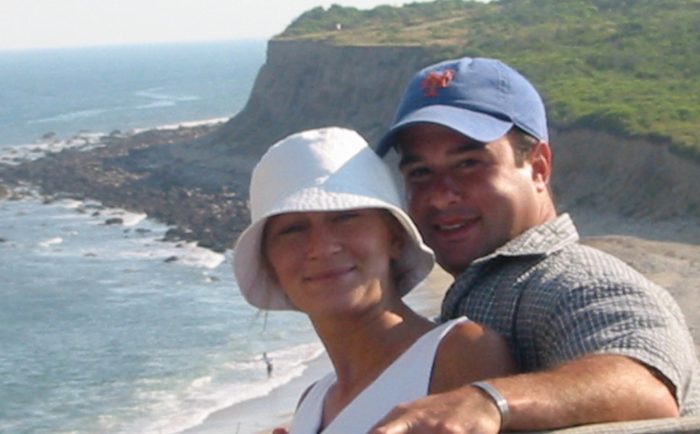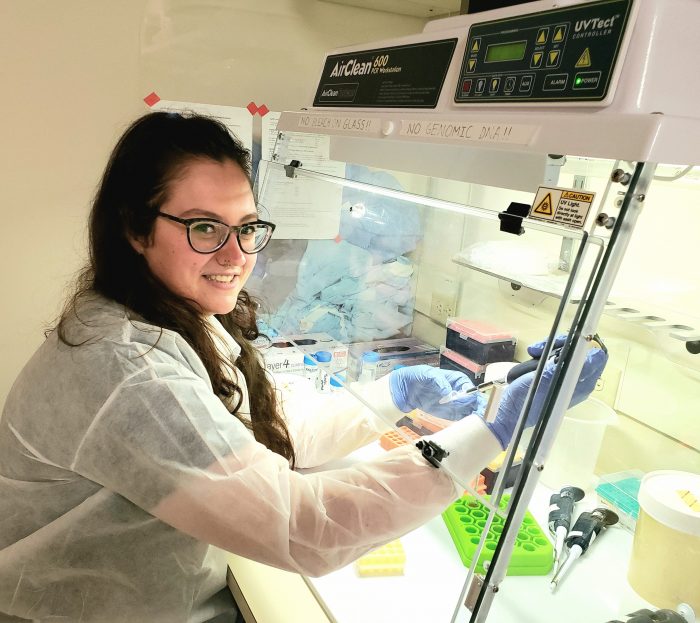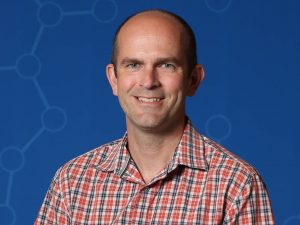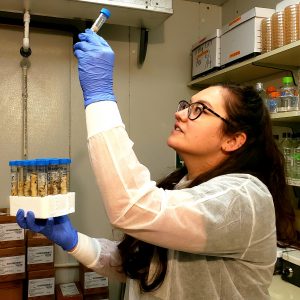By Daniel Dunaief
Part 2
Three families and their foundations jump-started a research mission on Long Island that offers a chance for change. Their stories reflect a desire to remember their family members and a need to offer hope and help to others.
Christina Renna
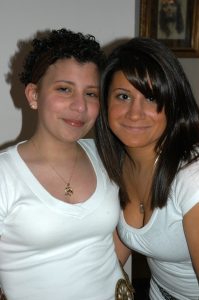
Phil Renna waited while his 16-year old daughter Christina spoke with her doctor. He and his wife Rene had decided to allow their daughter, who was battling a form of connective tissue cancer called rhabdomyosarcoma (RMS), to be involved in decisions about her treatment.
When Christina came out of the room, Phil, director of operations in the communications department at Cold Spring Harbor Laboratory, asked if he should also speak with the doctor. Christina said it wasn’t necessary. On the way home, she told him it had to be a “really good Christmas.”
He knew what that meant, although she also asked him not to tell anyone how close she was to the end of her life.
Renna and parents throughout the country have had to cope with the agony of rhabdomyosarcoma, which mostly affects children. People battling this cancer have turned to medicine for help, only to find that the treatment options are limited.
That, Renna and others say, was as unacceptable to them when their children were battling cancer as it is now, when the next generation is struggling with this illness.
RMS doesn’t receive the same level of funding nationally as cancers that affect more people, such as breast, lung and prostate cancer, but the agony and suffering are just as significant.
Amid their battles with the disease, families have turned to their support groups, including friends, extended family, and community members to raise funds for basic research, hoping grass roots efforts allow future generations to have longer, healthier lives.
Supported by these funds and a willingness to fill a research gap, Cold Spring Harbor Laboratory CEO Bruce Stillman has backed efforts to gather information and to support research that may also help people with other forms of cancer.
Renna, who lives in Lindenhurst, struggled with his role as father and protector when Christina developed rhabdomyosarcoma.
“I’m supposed to protect my kids,” Renna said. “I should be able to tell them, ‘It’s going to be okay.’”
Renna went to Stillman to ask whether Christina, who was a patient at Memorial Sloan Kettering, might get better care somewhere else.
After conducting some research, Stillman told his colleague about the lack of basic research and other treatment options.
“That was a crushing moment for me,” Renna said.
During treatment, Christina had to be at Memorial Sloan Kettering at 7 a.m., which meant he and Christina’s mother Rene got in the car at 5 a.m. with their daughter.
Renna dropped them off, drove back to work, where he’d put in a full day, drive back to the hospital and return home at 10:30 p.m.
“That was every night, five days a week,” Renna recalled. While those were tough days, Renna said he and his wife did what they needed to do for their daughter.
Five years after his daughter died at the age of 16, Renna drove home from work one day to find his shirt was wet. It took him a while to realize the moisture came from the tears, as he cried his way back to his house. At one point, he thought he had post-traumatic stress disorder.
Renna continues to raise money to support research into this disease, while also helping people create and develop their own foundations, often after enduring similar pain.
“Every single foundation that has come and given money to the lab, I have personally met with,” he said. “I helped our advancement team onboard them.”
As someone who has lost a child and understands what a parent can be feeling, Renna is committed to helping others cope with their grief.
“For me, it is about helping the lab, but also about helping families honor the memory of their child in a meaningful way and what better way than to help another family and perhaps find a cure,” he wrote in an email.
Renna believes investments in research will pay off, helping to answer basic questions that will lead to better treatments down the road.
So far, the foundation has given $387,300 to Cold Spring Harbor Laboratory for research. They also gave $50,000 to Make-a-Wish in Suffolk, and $25,000 to local scholarships. The foundation supported Memorial Sloan Kettering with an iPad program. Ultimately, Renna believes in the ongoing return from research investments.
“Everybody wants to find and fund the silver bullet,” he said. “Everybody wants to give money to fund a clinical trial. Basic research is where the discoveries are made.”
Renna urged people creating foundations to have a strong board that included business people and that might also have a scientific or medical advisory element. He also suggested funding foundations a year ahead of time. That helped his foundation in 2020, when finding donors became more challenging during the pandemic.
Being at Cold Spring Harbor Laboratory and helping others get through darker days that are all too familiar to him gives Renna comfort. “I know, in some way, every single day, I’m making an impact,” he said. “How measurable it is, I don’t know. There are days when I’m pretty proud.”
As far as he feels they have come, Renna said it’s not the time to look back, but to press ahead.
T.J. Arcati
A former summer intern in Bruce Stillman’s lab when he attended Notre Dame, T.J. Arcati was married and had two children when he succumbed to sarcoma.
“We know what we went through,” said his father, Tom Arcati, an oral and maxillofacial surgeon in Huntington. “He left a son and a daughter without a dad.”
Tom and his wife Nancy, who raised T.J. in Lloyd Harbor and live in Huntington, were with their son for his treatments and therapies.
Tom and Nancy Arcati are determined to extend people’s lives by more than a year or two and are actively engaged with other families who are coping in the midst of the cancer storm. “I’m talking to people now that unfortunately are going through what we did seven years ago,” Tom Arcati said.
While the Arcatis support other families, their empathy “brings you back to a place you never really leave,” Nancy Arcati said. These interactions “keeps T.J.’s life on people’s minds and in their hearts.”
Tom Arcati tries to be a source of solace to people who are trying to gather information.
In the aftermath of TJ’s death at the age of 34, Arcati reached out to Stillman to see if the lab could work towards better treatments.
One Saturday, Arcati and his son Matthew went to Stillman’s house, where they sat in his living room, with Stillman drinking tea and Arcati having coffee.“What do you think?” Arcati recalled asking. “Are you going to do sarcoma research?” Stillman looked back at his guest and mentioned that he was thinking about it. Stillman called Arcati a few days later.
“When he called me, he said, ‘We’re a cancer institute. We should be doing sarcomas.’ That’s how I remember this whole thing going down. It was pretty heart warming.”
The first step for CSHL was to host a Banbury conference. The site of international meetings on a range of scientific topics since 1978, the Banbury center brings together experts in various fields. The meetings provide a forum for scientific advances and result in various publications. By holding a Banbury Center meeting, CSHL helped advance research into sarcomas.
The Arcatis have remained active in the Friends of T.J. Foundation, which TJ and several college friends founded in 2009 after T.J. was diagnosed with sarcoma. They have stayed in close contact with CSHL Professor Chris Vakoc and his PhD student Martyna Sroka, who regularly keeps him informed of her progress. Sroka has spoken at some of the outings for the Friends of TJ Foundation. This year, Stillman will speak at the September 13th fundraiser at the Huntington Country Club.
“It’s really imperative that people who are supporting us know what their dollars are being spent on,” Arcati said.
The Friends of TJ Foundation has raised about $50,000 each year, bringing their total fundraising to about $400,000.
Arcati hopes something positive can come out of the losses the families who are funding Vakoc’s research suffered.
“If we can save one kid’s life somewhere by doing what we’re doing, then this whole process is worth it,” Arcati said.
Michelle Paternoster
Michelle Paternoster of Lindenhurst developed sarcoma in her sinuses. Her husband Paul Paternoster helped her through 38 surgeries, over 90 radiation treatments and several rounds of chemotherapy.
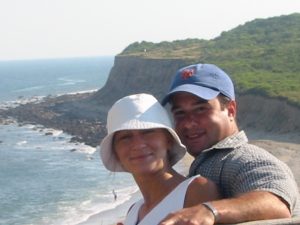
The couple tried immune therapy in the Bahamas in the fall of 2008 and went to New York in 2011 for treatment.
“We drove [to the city] for 90 days” excluding weekends, Paternoster recalled. The treatments seemed to have a positive effect during the trial, but shortly afterward, the cancer continued growing.
After Michelle died in 2013 at the age of 34, Paternoster was determined to help others, initially asking supporters to contribute to the fundraising effort from the Arcatis.
Donations to the Friends of T.J. Foundation reached $30,000, which helped underwrite the Banbury conference at Cold Spring Harbor Laboratory. Michelle and T.J. had seen each other in the radiation suite in the halls of Memorial Sloan Kettering.
Paternoster then started the Michelle Paternoster Foundation for Sarcoma Research. The President of Selectrode Industries Inc., which manufactures welding products and has two factories in Pittsburgh, Paternoster wanted to help people at a clinical level.
Through Michelle’s Clubhouse, he partnered with the Children’s Hospital of Pittsburgh, paying for hotels of pediatric cancer patients when the Ronald McDonald house is full. The clubhouse also provides gift cards to help pay for gas, tolls and copays on prescriptions.
“Knowing how difficult it is to go through this, I can’t imagine what it’s like to not have that capability” to pay for basic needs during treatment, Paternoster said. “That is why it is so important for our board to do something at the clinical level to support families in this battle.”
Paternoster said the relatively small but growing size of the group dedicated to helping each other makes each person’s contribution that much more important.
“Normally, when you’re doing any kind of charity work, you feel like you’re a tiny part of this project, especially when it comes to [diseases like] breast cancer and things that impact millions of people,” Paternoster said. When he attended the Banbury conference that launched the research effort at Cold Spring Harbor Laboratory, he said “you felt you could make a difference. You’re sitting in a room with 25, 30 people max. That was the entire effort to eradicate this disease.”
Paternoster, who lives in Cold Spring Harbor, called the collaboration that came out of the meeting “astounding.”
The Michelle Paternoster Foundation has raised $500,000, with about $350,000 of that supporting the work at Cold Spring Harbor Laboratory.
Ultimately, like the other families who raise funds, stay informed and offer help to strangers battling an all-too-familiar disease, Paternoster feels that the opportunity to make a meaningful contribution inspires him.
“That’s our dream,” he said, “to find a cure, so other people don’t have to feel what we felt.”
To read Part 1 of the article click here.

